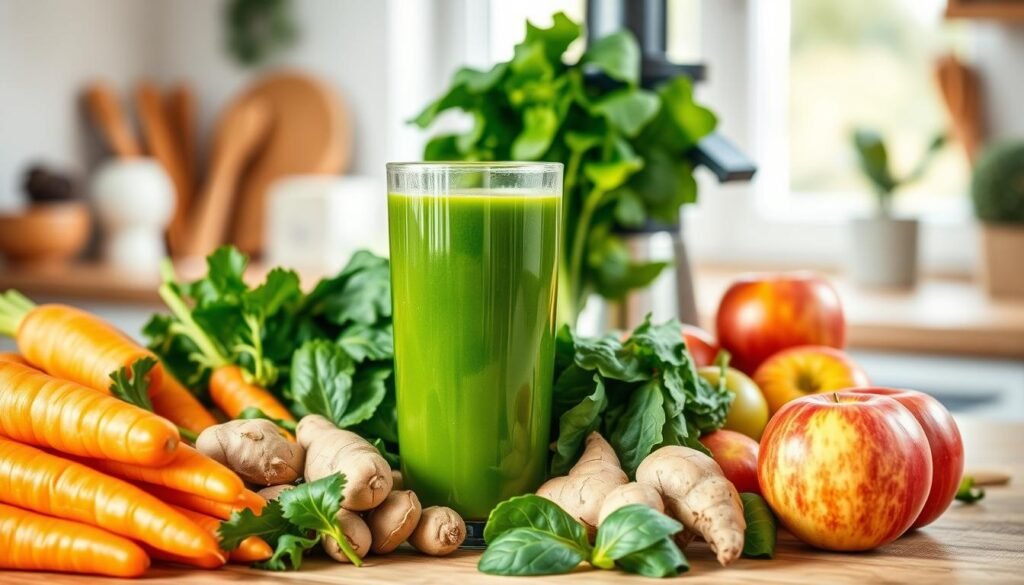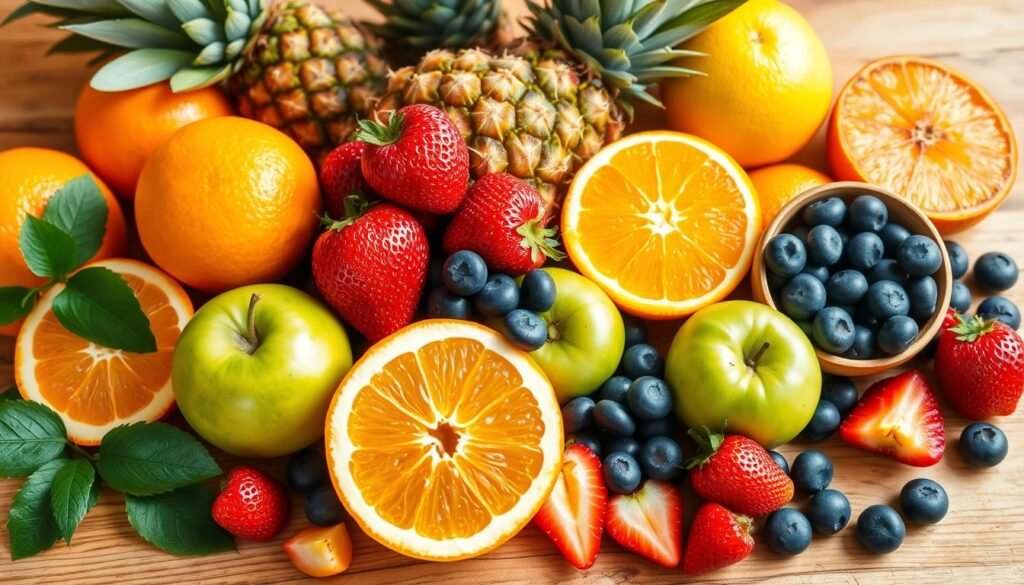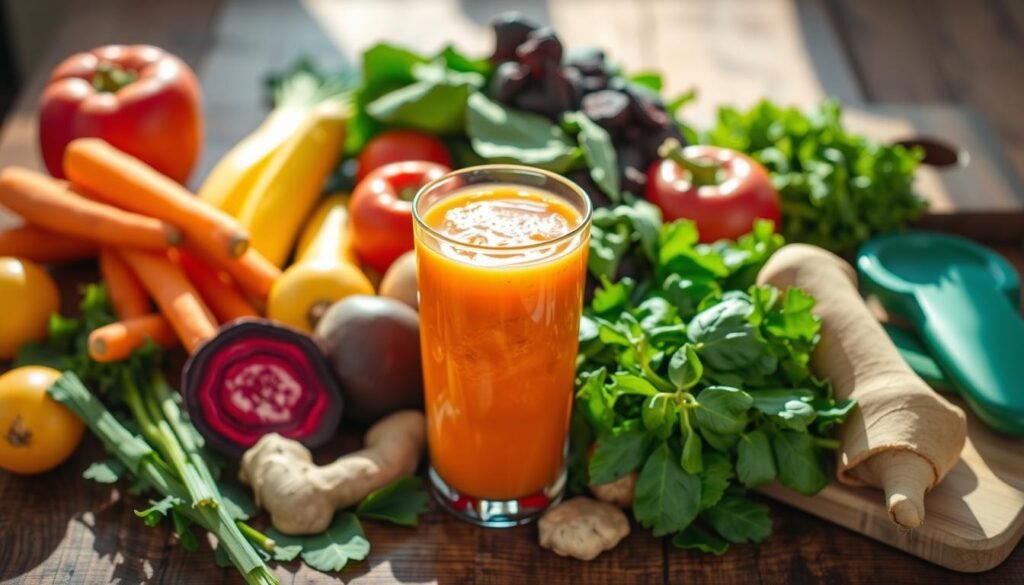Did you know nearly 90% of lung cancer patients struggle with nutrition? This affects their chance to get better. Taking in the right nutrients is key, making juicing a great choice for those with lung cancer. It helps with absorbing nutrients better, boosting their immune system, and easing discomfort from treatments.
Key Takeaways
- Juicing can enhance nutrient absorption for lung cancer patients.
- Fruits and vegetables rich in antioxidants may help combat cancer.
- Hydration plays a crucial role in overall health during treatment.
- Meeting with a specialized dietitian can provide tailored nutritional advice.
- Coconut water and herbal teas can be excellent hydration options.
- Regular juicing may ease side effects and improve overall wellness.
Understanding Lung Cancer and Nutrition
Eating right is key when you’re dealing with lung cancer. It keeps you strong and helps with recovery and quality of life. The right food choices boost your immune system. This helps you handle your condition and side effects better.
The Importance of Nutrition for Lung Cancer Patients
Nutrition is vital for those fighting lung cancer. They often struggle to get the nutrients they need. Eating foods rich in nutrients fights fatigue and helps with treatment effects.
Common Nutritional Challenges Faced
Patients often face dietary issues during cancer treatment. These include:
- Altered taste sensations, making familiar foods taste weird
- Dry mouth, which makes it hard to eat
- Difficulty swallowing, which can lead to skipping meals
- Weight loss, often because of not feeling hungry or nausea
Dealing with these issues is crucial. It helps patients get the nutrients they need. This supports better health results during and after treatment.
Benefits of Juicing for Lung Cancer
Juicing is great for lung cancer patients, helping their bodies absorb nutrients better. It gives the immune system the support it needs. Patients find it easier to take in the vitamins and minerals they need from juices. This is especially good for those who have trouble eating or don’t feel hungry.
Enhanced Nutrient Absorption
Juicing breaks down fruits and vegetables into a form that’s easy to digest. This way, lung cancer patients can easily get the important vitamins and minerals they need. Eating at least 2.5 cups of these foods every day may help lower cancer risk. Juices pull nutrients straight from the foods, making them more accessible. Adding juices to a healthy diet can make a big difference, according to experts.
Boosting the Immune System
Juices full of fresh fruits and vegetables can boost the body’s defense system. They have things like antioxidants, which fight off harmful reactions in our bodies. This includes using special fruits like the Japanese sarunashi, which is packed with vitamin C. These efforts help repair damaged cells, playing a key role in fighting cancer.
Relieving Side Effects of Treatments
Treatments for lung cancer can make patients feel sick, tired, and not hungry. Juices filled with nutrients can help overcome these issues, offering energy and hydration. They can include ingredients like ginger to help with nausea. Juices that are rich in calories and protein are also useful. They ensure patients keep getting the nutrients they need when eating is tough.
Juicing for Lung Cancer: A Natural Support Guide
Juicing is a key ally in lung cancer recovery. It provides crucial nutrients that support wellness during treatment. These nutrients include vitamins, minerals, and antioxidants, important for a cancer-fighting diet.
How Juicing Aids Recovery and Wellness
Juices offer many benefits in lung cancer recovery. They tackle side effects from treatments. For example, apple and ginger juices reduce nausea with their calming effects. Also, juices with high fiber help with constipation, improving digestive health.
During treatment, it’s common to feel tired. Energy-boosting juices, like the Green Machine, can improve vitality. Juices that are tart can help with dry mouth by increasing saliva.
Weight loss and low appetite are common during cancer treatment. Calorie and protein-rich juices combat these issues. The Power Protein Juice helps maintain strength. Overall, juicing plays a crucial role in balanced nutrition for recovery.
To lower cancer risks, aim for at least 2.5 cups of fruits and veggies daily. This is also advised by health experts. For tips on juicing, check out this resource.

Best Fruits and Vegetables for Juicing
Adding the right fruits and veggies to juice recipes helps lung cancer patients get more nutrition. The best fruits add flavor and vital nutrients for health. Here are great picks.
Top Antioxidant-Rich Fruits
Fruits are key for their antioxidants, fighting stress and inflammation. Here are some top fruits for their health benefits:
- Berries: Strawberries and blueberries have anthocyanin, which helps lungs and may slow lung aging.
- Pineapple: It has bromelain, an enzyme that eases congestion and helps breathing.
- Apples: Apple juice has quercetin and catechin, boosting the immune system.
- Pomegranate: The fruit and juice help reduce effects of lung issues, including cancer.
Essential Vegetables for Lung Cancer Juices
Vegetables are rich in vital vitamins and minerals. They are key during treatment. Here are some must-have veggies:
- Carrots: With vitamins A, C, and lycopene, carrot juice aids lung health and lessens lung disease risk.
- Spinach: Full of vitamin C and antioxidants, spinach juice boosts immunity and lung function.
- Beets: They increase oxygen uptake and are nutrient-rich for lung health.
- Tomatoes: Tomato juice, with lycopene, promotes better breathing by aiding bronchodilation.
For juicing that’s rich in vitamins, check out these recipes for lung cancer patients. They use these powerful ingredients to help with recovery.

Juicing Recipes for Lung Cancer Patients
Juicing is a great way for lung cancer patients to get important nutrients. It’s delicious and easy on the stomach. These recipes aren’t only tasty; they are also full of health benefits. They aim to provide vitamins and antioxidants important for recovery.
Carrot and Apple Juice
This juice blends apple’s sweetness with carrot’s nutrients. It’s as nutritious as eating five cups of sliced carrots. Carrots contain carotenoids, which may lower cancer risks and boost lung health. This juice is also good for staying hydrated and fighting dry mouth, often caused by treatments.
Spinach, Cucumber, and Celery Juice
Here’s a juice that’s packed with vitamins and minerals. It mixes leafy greens and cucumber for hydration. Spinach offers antioxidants that fight inflammation. The mild flavors of cucumber and celery make this drink both refreshing and healthy. It supports overall health and might ease treatment side effects like nausea.
Pineapple, Blueberry, and Ginger Juice
This juice combines pineapple’s tropical taste with blueberries’ antioxidants. Pineapple has bromelain, which can help with digestion and reduce inflammation. Blueberries are nutrient-rich and may guard against cancer. Ginger adds a spicy note and helps fight nausea. This colorful juice is perfect for lung cancer patients wanting a nutritional lift.

Getting Started with Juicing
Starting your juicing journey can be exciting. It’s important to choose the right juicer and learn how to prepare your fruits and veggies. This will make your juicing experience better and more beneficial.
Choosing the Right Juicer
There are many juicers to pick from. Juice extractors are great because they let you make lots of different juices. If you like simple citrus juices, citrus juicers are perfect. Keep in mind these important points:
- Ease of cleaning: Choose a juicer that’s easy to clean for health reasons.
- Space and storage: Make sure you have enough room for your juicer.
- Juice quality: Look for juicers that make nutrient-rich juice.
Preparation and Cleaning Tips
Getting your fruits and veggies ready is key to good juicing. Always wash them to remove any chemicals or dirt. You might need to peel some fruits, depending on what you like. After you’re done juicing, clean your juicer right away.
Following these steps will make juicing a valuable part of your health routine. If you’re dealing with lung cancer, it’s even more crucial. Good habits in preparing and cleaning can help improve your nutrition and wellness.
Juicing Safety and Considerations
It’s key to focus on juicing safety for those with lung cancer. Juice offers health benefits but knowing what’s inside is key. Watch the sugar, as too much from fruits can be risky, especially for diabetes.
Avoiding Excessive Sugar Intake
It’s easy to drink too much sweet fruit juice, which can pack lots of sugar. A 6-ounce glass of 100% fruit juice may have 15-30 grams of sugar. Juice moderately to enjoy flavors without overdoing sugar. Choose whole fruits instead for fiber and less sugar.
Consulting with Healthcare Providers
Talk to healthcare providers before adding juice to your diet. They guide you on juicing safely with your treatment, checking for medication issues and hydration. Lung cancer patients need to be extra careful with food safety to avoid illness. Handling, storing, and preparing food correctly reduces foodborne illness risks. Check this resource to understand hydration’s role in cancer treatment.
| Food Safety Guidelines | Recommendations |
|---|---|
| Avoid raw or undercooked foods | Includes eggs, meats, and fish |
| Opt for pasteurized products | Milk, cheese, and yogurt should be pasteurized |
| Store food properly | Avoid bulk-bin sources, use pre-packaged items |
| Ensure clean water sources | Drink from regulated sources; avoid well water without guidance |
| Select commercial food options | Commercially prepared items are generally safer |
Juicing for Lung Cancer Survivors
After lung cancer treatment, keeping a healthy diet is key for survivors. A good diet helps support health and energy levels. Juicing adds essential vitamins and nutrients easily to daily life. It makes getting more fruits and vegetables simpler.
Maintaining a Healthy Diet Post-Recovery
Survivors should drink a variety of juices with vitamins A, C, potassium, and folate. Eating five servings of fruits and vegetables a day is good for health. Juicing more vegetables than fruits keeps calories low and nutrients high. Adding protein to juices makes them a fuller meal, important for healing.
Community Support and Resources
For lung cancer survivors, joining support groups is essential. These groups offer help and share experiences to keep healthy eating habits. They share juicing tips and recipes that help after recovery. For example, there are many juicing recipes online to improve health and make the process fun and shared.
Conclusion
Juicing offers hope alongside standard cancer treatments. It’s a natural way to boost health during lung cancer recovery. Using juices, particularly from the sarunashi fruit, supports the immune system and overall health.
This guide underlines how absorbing nutrients and antioxidants helps fight cancer. Remember, juicing is a support, not a standalone cure. It works best with doctors’ advice and balanced nutrition.
Sharing experiences in community support groups helps too. It lets patients make educated food choices that fit their treatment and likes.
Adopting juicing and a holistic lifestyle can enhance lung cancer patients’ lives. It teaches the importance of drinking enough water, absorbing nutrients, and community support. Through these, patients can face their diagnosis with courage and optimism.